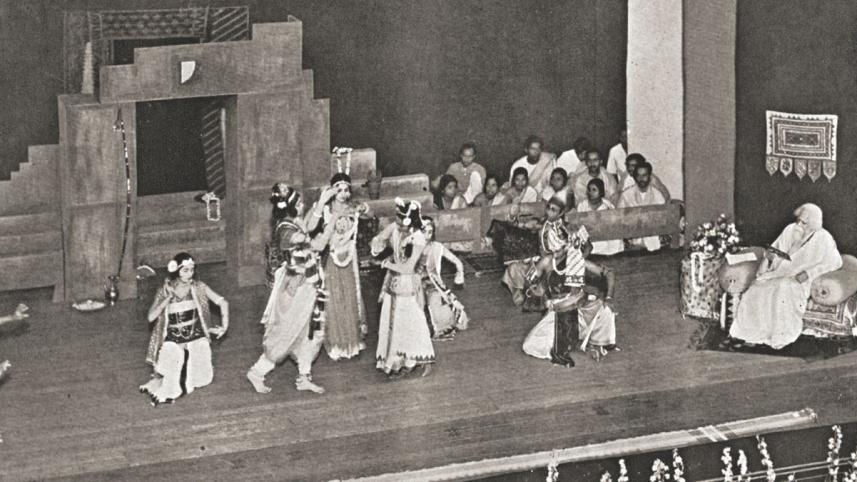The legacy lives on...

Tagore's childhood in Jorasanko (a locality of Kolkata) was culturally very rich. The environment was enlivened with performances by renowned maestros and talented jatra artistes. Even in his early years, Tagore displayed a taste for jatragaan and was inclined to act in plays. Rabindranath began writing plays at a relatively young age and also managed to enact those written by the children of his family. Except for one or two performances in his early years, most of the time he used to play the role of the complex characters or the protagonist of his own plays. Simultaneously, he would take on the mantle of play director.
Tagore's early dramas featured only the artistes from his family. He also did excellent work grooming theatre activists.
"Mukto Kuntola", was among the first plays that Tagore launched in his boyhood. "Mukto Kuntola" had the touch of a foreign stage play and not that of jatra. Even though Tagore's thoughts about theatre somewhat changed later, there was a distinct influence of the West in his productions starting from "Balmiki Pratibha" (1881) to "Kal Mrigoya("1882)", Raja o Rani "(1889) and "Bishorjan "(1890). As the Shakespearean style was followed in Tagore's plays, the stage decoration and the planning of scenes were also inspired by western theatre.
Later, Tagore thought of dropping redundancy from acting. This philosophy was reflected in his works like "Sarodotsab" (1908) through several Nrityanattyas (dance dramas) that were staged at the end of his life. This can be termed as the 'Shantiniketan Phase' in the history of Rabindra Nattya. In this phase, the plays produced by Tagore had simple but indicative symbols in stage decoration. The play "Raja" in 1910 was also performed in the same style.
There were several pragmatic reasons for promoting a new trend in theatre as exemplified in the 'Shantinikatan Phase'. Because of financial constraints, it was not possible to have expensive stage sets.
As there was no opportunity for women at that time to pursue their studies in Shantiniketan, men used to play their roles in plays like "Raja" or "Prayoshchitto".
The stage setting of "Falguni("1916) or "Dakghar" (1917), staged in Kolkata, was a bit heavy but helped deliver the theme symbolically.
Although "Raja o Rani" (1889)and "Bishorjan"(1890) were staged following the western style of theatre, the later adaptation of these two plays-" Tapoti "(1929) --revealed Tagore's new ideology of theatre. Symbolic features, dropping still background, continuous acting, creating characters like Vivek-- all these elements clearly bear an indication of a very new theatre ideology.
Rabindranath always believed that it was jatra and not theatre which was a strong weapon for mass communication.
Since 1921, in his seasonal Geetinattya (musical drama) and Nrityanattya (dance drama)- Rabindranath began to give priority to our very own jatra style. This very style was pursued in staging "Shesh Barshan", "Srabon Gatha", "Bashanto", "Shundor" and "Nataraj".
"Rabindranath was always fascinated by dance and acknowledged the invaluable role of this performing art in acting. Since "Kal Mrigoya" (1882), Tagore included little girls of his family even for auxiliary characters like 'Bon Devi'. Rabindranath himself was adept in dancing. He featured efficiently as the dancer Thakurda in "Raja", Kabishekhar and Andho Baul in "Falguni "and Baul in "Dakghar".
A harmonious bridge between music and dance was visible in Geetinattya like "Bashanto"(1923), "Shesh Barshan" (1925), "Shundor" (1925) "Nataraj "(1927) and "Gitotsav"(1931). Later on, the subject of plays was gradually presented in the form of dance.
Rabindranath's role was that of a director-producer in the 'Nrityanattya phase'. The plays were rehearsed before him. He would often sit on the right side of the stage and at times took part in the music, reading and recitation.
Though less known as an actor and director in stage plays, Tagore's legacy lives on in the form of simple stage sets and the inclusion of dance in theatre.



 For all latest news, follow The Daily Star's Google News channel.
For all latest news, follow The Daily Star's Google News channel.
Comments